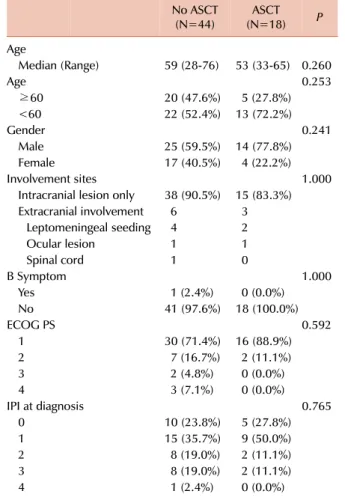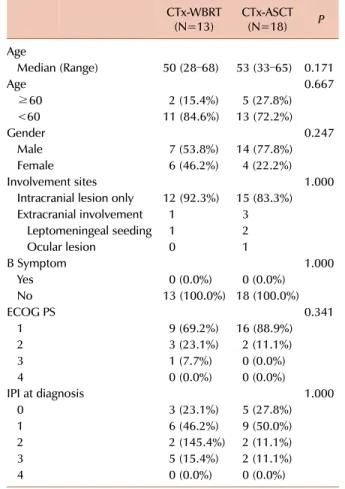155
This is an Open Access article distributed under the terms of the Creative Commons Attribution Non-Commercial License (http://creativecommons.org/licenses/by-nc/3.0) which permits unrestricted non-commercial use, distribution, and reproduction in any medium, provided the original work is properly cited.
Table 1. Characteristics of patients who received different treatments (N=62).
No ASCT
(N=44) ASCT
(N=18) P
Age
Median (Range) 59 (28-76) 53 (33-65) 0.260
Age 0.253
≥60 20 (47.6%) 5 (27.8%)
<60 22 (52.4%) 13 (72.2%)
Gender 0.241
Male 25 (59.5%) 14 (77.8%)
Female 17 (40.5%) 4 (22.2%)
Involvement sites 1.000
Intracranial lesion only 38 (90.5%) 15 (83.3%) Extracranial involvement 6 3
Leptomeningeal seeding 4 2
Ocular lesion 1 1
Spinal cord 1 0
B Symptom 1.000
Yes 1 (2.4%) 0 (0.0%)
No 41 (97.6%) 18 (100.0%)
ECOG PS 0.592
1 30 (71.4%) 16 (88.9%)
2 7 (16.7%) 2 (11.1%)
3 2 (4.8%) 0 (0.0%)
4 3 (7.1%) 0 (0.0%)
IPI at diagnosis 0.765
0 10 (23.8%) 5 (27.8%)
1 15 (35.7%) 9 (50.0%)
2 8 (19.0%) 2 (11.1%)
3 8 (19.0%) 2 (11.1%)
4 1 (2.4%) 0 (0.0%)
Abbreviations: ECOG PS, Eastern Cooperative Oncology Group performance status; IPI, international prognostic index; ASCT, autologous stem cell transplantation.
http://dx.doi.org/10.5045/kjh.2012.47.2.155 The Korean Journal of Hematology Volume 47ㆍNumber 2ㆍJune 2012
Letter to the Editor
Relapse pattern and prognostic factors for patients with primary CNS lymphoma
THE AUTHORS’ REPLY: We thank Dr. Dahiya and his co-in- vestigator for their interest in our paper. We totally agree with Dr. Dahiya on the importance of patient characteristics for evaluating the outcome of chemotherapy followed by autologous stem cell transplantation (CTx-ASCT) for pri- mary CNS lymphoma (PCNSL).
We compared the baseline characteristics of all patients, except 3 patients who received best supportive care only (Table 1). Age, Eastern Cooperative Oncology Group (ECOG) performance status (PS), and international prog- nostic index (IPI) of patients who received CTx-ASCT were not significantly different from those of patients who re- ceived other treatments. Complete response (CR) or partial response (PR) was shown by 100%, 62.1%, and 84.6% of the patients treated with CTx-ASCT, CTx only, and CTx followed by whole brain radiotherapy (CTx-WBRT), re- spectively [1]. The selection bias due to exclusion of patients who were refractory to chemotherapy might have con- tributed to the better outcome of CTx-ASCT. Nonetheless, 5 of the 18 patients who showed PR after CTx achieved CR after ASCT, suggesting that ASCT might have improved the clinical outcomes in these patients.
Characteristics (Age, ECOG PS, and IPI) of patients who received CTx-WBRT and CTx-ASCT were not significantly different (Table 2), but compared to CTx-WBRT, CTx-ASCT had better response, as shown in our previous report [1].
We did not assess the risk of neurotoxicity due to lack of data, but the risk of acute and late neurotoxicity after WBRT is well described by previous studies [2-4]. A previous study showed that CTx-WBRT affords the benefit of im- proved progression-free survival, but the increased risk of
neurotoxicity limits this benefit [5]. Our study has limi- tations of retrospective design, such as patient selection bias and lack of data on treatment-related toxicity including
Korean J Hematol 2012;47:155-6.
156 Letter to the Editor
Table 2. Comparison of characteristics of patients who received subsequent treatment after chemotherapy (N=31).
CTx-WBRT
(N=13) CTx-ASCT
(N=18) P
Age
Median (Range) 50 (28–68) 53 (33–65) 0.171
Age 0.667
≥60 2 (15.4%) 5 (27.8%)
<60 11 (84.6%) 13 (72.2%)
Gender 0.247
Male 7 (53.8%) 14 (77.8%)
Female 6 (46.2%) 4 (22.2%)
Involvement sites 1.000
Intracranial lesion only 12 (92.3%) 15 (83.3%) Extracranial involvement 1 3
Leptomeningeal seeding 1 2
Ocular lesion 0 1
B Symptom 1.000
Yes 0 (0.0%) 0 (0.0%)
No 13 (100.0%) 18 (100.0%)
ECOG PS 0.341
1 9 (69.2%) 16 (88.9%)
2 3 (23.1%) 2 (11.1%)
3 1 (7.7%) 0 (0.0%)
4 0 (0.0%) 0 (0.0%)
IPI at diagnosis 1.000
0 3 (23.1%) 5 (27.8%)
1 6 (46.2%) 9 (50.0%)
2 2 (145.4%) 2 (11.1%)
3 5 (15.4%) 2 (11.1%)
4 0 (0.0%) 0 (0.0%)
Abbreviations: ECOG PS, Eastern Cooperative Oncology Group performance status; IPI, international prognostic index; WBRT, whole brain radiotherapy; ASCT, autologous stem cell trans- plantation; CTx-WBRT, chemotherapy followed by whole brain radiotherapy; CTx-ASCT, chemotherapy followed by autologous stem cell transplantation.
neurotoxicity; therefore, the benefits of ASCT after CTx should be verified by a prospective analysis. However, such a prospective trial would be difficult to conduct, considering the rarity of PCNSL, different treatment strategies in differ- ent institutions, and treatment-related toxicities.
In conclusion, CTx-ASCT improves outcomes in PCNSL patients and results in better response rate and failure free survival, as shown by multivariate analysis conducted for a single center cohort of patients treated with relatively consistent treatment strategies. Further, the baseline charac- teristics of patients who received different treatments were similar.
Cheolwon Suh, M.D., Ph.D., Jeong Eun Kim, M.D., Ph.D., Dok Hyun Yoon, M.D., Ph.D.
Department of Oncology, Asan Medical Center, University of Ulsan College of Medicine, 88, Olympic-ro 43-gil, Songpa-gu, Seoul 138-736, Korea Tel: +82-2-3010-3209, E-mail: csuh@amc.seoul.kr
1. Kim JE, Yoon DH, Kim S, et al. Relapse pattern and prognostic fac- tors for patients with primary central nervous system lymphoma.
Korean J Hematol 2012;47:60-6.
2. DeAngelis LM, Seiferheld W, Schold SC, Fisher B, Schultz CJ.
Combination chemotherapy and radiotherapy for primary central nervous system lymphoma: Radiation Therapy Oncology Group Study 93-10. J Clin Oncol 2002;20:4643-8.
3. Ferreri AJ, Crocchiolo R, Assanelli A, Govi S, Reni M. High-dose chemotherapy supported by autologous stem cell transplantation in patients with primary central nervous system lymphoma: facts and opinions. Leuk Lymphoma 2008;49:2042-7.
4. Morris PG, Abrey LE. Therapeutic challenges in primary CNS lymphoma. Lancet Neurol 2009;8:581-92.
5. Thiel E, Korfel A, Martus P, et al. High-dose methotrexate with or without whole brain radiotherapy for primary CNS lymphoma (G-PCNSL-SG-1): a phase 3, randomised, non-inferiority trial.
Lancet Oncol 2010;11:1036-47.

